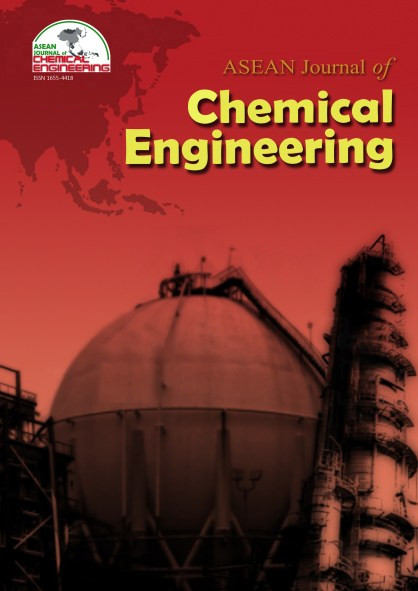Biodiesel Production From Calophyllum Inophyllum Using Base Lewis Catalyst
Abstract
The search for renewable alternative energy must be developed, one of which is biodiesel. Seed Calophyllum inophyllum has a fairly high oil content of about 71.4% by weight, has great potential when used as raw material for making biodiesel. The purpose of this research was to synthesize biodiesel from Calophyllum inophyllum oil through the transesterification process using base lewis catalyst with microwave assisted, comparing the performance of sodium acetate to potassium hydroxide, knowing the amount of catalyst required to obtain the best biodiesel, and knowing the optimum power in the manufacture of biodiesel, The first step of making Calophyllum inophyllum biodiesel is degumming process, then continued with esterification. The next process is transesterification, followed by purification of biodiesel. The catalysts used are CH3COONa, and KOH. From the results, Calophyllum inophyllum oil can be used as biodiesel feedstock, the best operating conditions for base catalyst at 300 W power, 1% (w/w) concentration, produced the best yield is 96% (for KOH catalyst) and 87% (for CH3COONa catalyst).
References
2. Alamsyah, R., Lubis, E.H., Siregar, N.C., Balai, (2011). Esterifikasi-transesterifikasi dan karakterisasi mutu biodiesel dari biji jarak pagar ( 33, 124–130.
3. Atabani, A.E., (2011). Calophyllum inophyllum L . as a potential feedstock for bio-diesel production 1–8.
4. Avhad, M.R., Marchetti, J.M., (2015). A review onrecent advancement in catalytic materials for biodiesel production. Renew. Sustain. Energy Rev. 50, 696–718. doi:10.1016/j.rser.2015.05.038
5. British Petroleum, (2017). BP Statistical Review of World Energy 2017, British Petroleum. doi:http://www.bp.com/content/dam/bp/en/corporate/pdf/energy-economics/statistical-review-2017/bp-statistical-review-of-world-energy-2017-full-report.pdf
6. Comyns, E.A.E., (2007). Encyclopedic dictionary of named processes in chemical technology, 3rd edn, Focus on Catalysts. doi:10.1016/S1351-4180(07)70686-4
7. Di Serio, M., Tesser, R., Dimiccoli, M., Cammarota, F., Nastasi, M., Santacesaria, E., (2005). Synthesis of biodiesel via homogeneous Lewis acid catalyst. J. Mol. Catal. A Chem. 239, 111–115. doi:10.1016/j.molcata.2005.05.041
8. Kirubakaran, M., Arul Mozhi Selvan, V., (2018). A comprehensive review of low cost biodiesel production from waste chicken fat. Renew. Sustain. Energy Rev. 82, 390–401. doi:10.1016/j.rser.2017.09.039
9. Motasemi, F., Ani, F.N., (2012). A review on microwave-assisted production of biodiesel. Renew. Sustain. Energy Rev. 16, 4719–4733. doi:10.1016/j.rser.2012.03.069
10. Muhammad, Fatih Ridho, Safetyllah Jatranti, Lailatul Qadariyah, M., (2014). Pembuatan Biodiesel dari Minyak Nyamplung Menggunakan Pemanasan Gelombang Mikro. J. Tek. Pomits 3, 154–159.
11. Nugraha, S., (2016). Energy Outlook Indonesia. Kementerian Energi dan Sumber Daya Mineral, Jakarta Selatan.
12. Pan, Y., Alam, M.A., Wang, Z., Wu, J., Zhang, Y., Yuan, Z., (2016). Enhanced esterification of oleic acid and methanol by deep eutectic solvent assisted Amberlyst heterogeneous catalyst. Bioresour. Technol. 220, 543–548. doi:10.1016/j.biortech.2016.08.113
13. Puspitahati, Saleh, E., Sutrisno, Eko, (2011). Pemisahan Getah (Gum) Pada Minyak Nyamplung (Crude Calophyllum Oil ) Menggunakan Zeolit Dan Karbon Aktif Menjadi Rco (Refine Calophyllum Oil ) 1–15.
14. Sudradjat, R., Sahirman, Suryani, A., Setiawan, D., (2010). Transesterification Process in Biodiesel Manufacture Using Esterified Nyamplung Oil (Calophyllum inophyllumL .) as Raw Material ) 184–198.
15. Supriya B. Chavan, Yadav, M., Singh, R., Singh,V., Kumbhar, R.R., Sharma, Y.C., (2014). Production of Biodiesel from Three Indigenous Feedstock: Optimization of Process Parameters and Assessment of Various Fuel Properties. Environ. Sci. Technol. 33, 482–489. doi:10.1002/ep
16. Trombettoni, V., Lanari, D., Prinsen, P., Luque, R., Marrocchi, A., Vaccaro, L., (2017). Recent advances in sulfonated resin catalysts for efficient biodiesel and bio-derived additives production. Prog. Energy Combust. Sci. 0. doi:10.1016/j.pecs.2017.11.001
17. Wati, A., Motto, S.A., Satriadi, H., (2011). Ekstraksi Minyak Dari Mikroalga Jenis Chlorella Sp Berbantukan Ultrasonik 8, 1–7.
Copyright holder for articles is ASEAN Journal of Chemical Engineering. Articles published in ASEAN J. Chem. Eng. are distributed under a Creative Commons Attribution-NonCommercial 4.0 International (CC BY-NC 4.0) license.
Authors agree to transfer all copyright rights in and to the above work to the ASEAN Journal of Chemical Engineering Editorial Board so that the Editorial Board shall have the right to publish the work for non-profit use in any media or form. In return, authors retain: (1) all proprietary rights other than copyright; (2) re-use of all or part of the above paper in their other work; (3) right to reproduce or authorize others to reproduce the above paper for authors’ personal use or for company use if the source and the journal copyright notice is indicated, and if the reproduction is not made for the purpose of sale.



